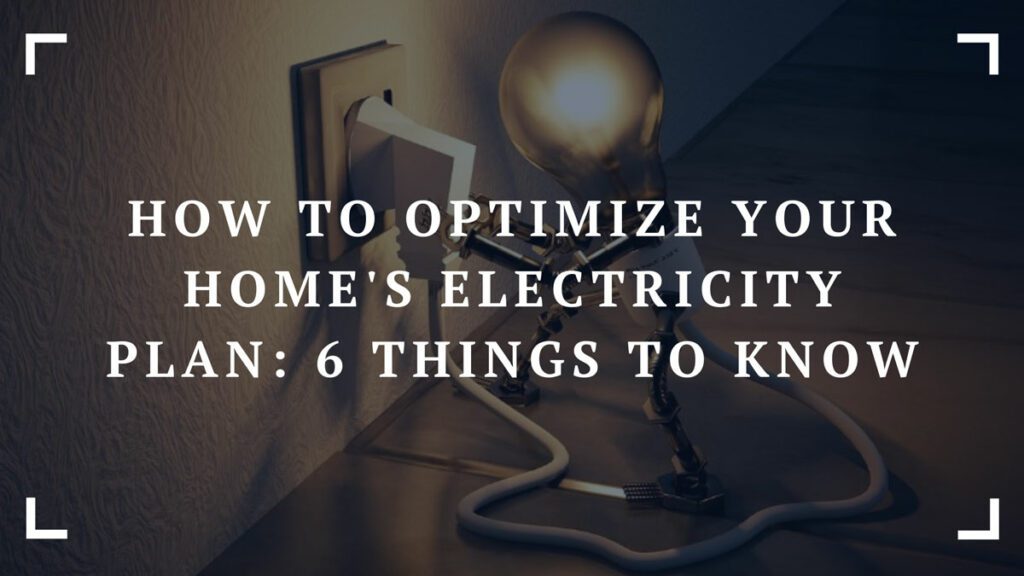Electricity is the lifeblood of modern homes. It powers appliances, keeps people connected, and provides the expected comfort. However, effectively managing your home’s electricity plan can lead to significant savings, environmental benefits, and a more reliable power supply. This comprehensive guide explores six essential things you need to know to optimize your home’s electricity plan, whether you’re looking to reduce your energy bills, minimize your carbon footprint, or ensure a more consistent power supply.

Choosing the Right Electricity Plan
Electricity providers typically offer various plans, tariffs, and pricing structures. Understanding the options available to you is essential for optimizing your electricity plan. Don’t settle for the first electricity provider that serves your area. Shop around and compare providers to find the best electricity options that fit your needs. Online comparison tools and websites can help you assess the options available in your region. Consider the contract length when selecting a plan. Shorter contracts provide flexibility but may have higher rates. More extended contracts can lock in favorable rates but reduce flexibility if you want to switch plans or providers.
Understanding Your Electricity Usage
Before you can optimize your home’s electricity plan, you must clearly understand how and where you use electricity. Conducting an energy audit is an excellent starting point. You can hire a professional auditor or perform a DIY audit.
- Professional Audit: An energy auditor can comprehensively assess your home’s energy usage. They use specialized tools to identify areas of energy waste, such as air leaks, inefficient appliances, or inadequate insulation.
- DIY Audit: If you prefer a more hands-on approach, you can perform a DIY energy audit. Start by reviewing your utility bills to understand your historical usage. Walk through your home to identify energy-efficient and inefficient aspects, like leaky windows, outdated appliances, and drafty doors.
Reducing Energy Consumption
Invest in energy-efficient appliances and lighting. Opt for products with the ENERGY STAR label, indicating that they meet energy efficiency standards. While these appliances have a higher upfront cost, they can lead to substantial long-term savings. Proper insulation and sealing are crucial for maintaining a comfortable and energy-efficient home. Insulating your home helps regulate indoor temperature, reducing the need for excessive heating or cooling. Seal gaps and cracks in doors, windows, and walls to prevent drafts and energy loss. Programmable thermostats let you control your home’s temperature settings automatically. You can schedule heating and cooling to reduce energy consumption when you’re not at home or sleeping.
Replace incandescent bulbs with energy-efficient LED or CFL bulbs. These alternatives use significantly less energy and last longer. Additionally, consider installing motion sensors and intelligent lighting systems to reduce unnecessary usage. Many electronic devices consume energy, even when turned off. Using power strips for devices like TVs, computers, and entertainment systems makes it easy to disconnect multiple devices at once. Unplugging chargers and appliances that are not in use can also save energy.
Implementing Renewable Energy
Installing solar panels in your home is a significant step toward energy optimization. Solar panels generate electricity from sunlight, reducing your reliance on grid power. They can also allow you to feed excess energy into the grid, potentially earning you credits or payments from your electricity provider. Small wind turbines can complement your electricity supply in areas with sufficient wind resources. Wind energy can be harnessed effectively to generate power for your home. Pairing renewable energy sources like solar panels or wind turbines with battery storage systems can optimize your home’s electricity plan. These batteries store excess energy generated during sunny or windy days and release it when needed, reducing your dependence on the grid.
Managing Peak Demand
If your electricity plan includes time-of-use pricing, it’s crucial to understand and adapt your electricity usage patterns. Shift energy-intensive tasks, such as laundry and dishwashing, to off-peak hours when rates are lower. Incorporate smart home technology to manage peak demand more effectively. Smart thermostats, appliances, and energy management systems allow you to control and schedule energy usage remotely.
Monitoring and Analytics
Use energy monitoring tools and apps to track your energy consumption in real time. These tools provide insights into your usage patterns, allowing you to make informed decisions about energy optimization. Regularly conduct energy audits and inspections to identify areas for improvement. Address issues like inefficient appliances, insulation gaps, or leaky doors promptly. Check with your utility provider for programs and incentives designed to encourage energy-efficient practices. These may include rebates for energy-efficient upgrades, free energy audits, or participation in demand response programs.

Optimizing your home’s electricity plan is about saving money and contributing to a sustainable future. You can create an efficient and eco-friendly home by understanding your energy usage, selecting the right plan, reducing consumption, and incorporating renewable energy sources. Managing peak demand, utilizing innovative technology, and monitoring your energy use empowers you to take control of your electricity consumption and make informed decisions that benefit your wallet and the environment. Embrace these strategies, and you’ll find that optimizing your home’s electricity plan is worth undertaking.


